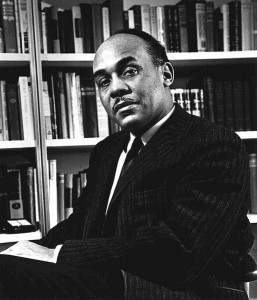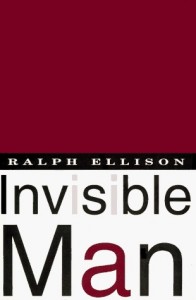
Ralph Ellison wrote Invisible Man, a novel that refined the shape of American literature. This novel reflects America’s racial divide in the late 1940’s and early 1950’s through an anonymous black man’s journey (the narrator). Ellison uses an array of themes, motifs and symbols to get his message across. Throughout Invisible Man, Ellison also incorporates many parables and legends, important to the ultimate message. I would define parables as stories that teach a lesson and legends as how stories came to be. Below are a few examples of each.
Example of Legends
- Story Behind the Narrator
The narrator’s frame of mind and how he thinks he is what he was taught and raised to think, through his grandfather and his ideologies about the white man.
The advice given by his grandfather is to fight back as hard as he can against people against blacks, even when he is gone he wants his grandson to keep fighting.(Ellison 16) “Let ’em swoller you till they vomit or bust wide open”
“The narrator’s difficulty in leaving his past behind resonates throughout his story, from the recurring voice and image of his grandfather to the physical reminders of his past that he carries with him throughout the novel.” (Dykema-VanderArk)
- Jim Trueblood’s Story
Trueblood tells his personal story to Mr. Norton and the narrator about his sexual encounter with his daughter. The narrator is disgusted with the incest, but since Mr. Norton (the white Trustee the narrator is watching over) is so interested the narrator has no choice. Trueblood later explains to the men how he was treated after the incident. He expressed that ‘his people’ were repulsed by his action, while white people sort of glorified him and showered him with money, nice things, and gave him respect. This is all a sort of entertainment to the white people and even Mr. Norton, feeding into his imagination, he later gives Trueblood a hundred dollar bill. The narrator is confused about this action and this is where he starts to question what he has to do to grab the attention of the white man.
“In his frank enjoyment and his strong sense of mutuality, Trueblood possesses a more complete identity, is more fully a man, than any other figure in the book. In contrast with the puritanical self-suppression and sublimation of Mr. Norton, the white millionaire, Trueblood’s self-acceptance makes him whole yet keeps him from the chaos that Norton fears.” (Langman) The legend and how this relates to the narrator is how this and the battle royal came to be and how it sort of sets up the upcoming scenes and just how humiliation maybe apart of reaching the heights he wants reach.
Examples of Parables
- Battle Royale
In the Battle Royal the narrator’s intention was to recite his speech. But with the series of events it leads the narrator and some of his African American classmates in a ring in front of wealthy white men for their pleasure. The narrator was in a rude awakening to be in those circumstances, seeing that he only wanted to deliver his speech and be recognized for it. With what the invisible man had to go through he learned a lesson in that race doesn’t determine character. Situational Irony is also seen within this because in specific situation the white men were going crazy over the dancing woman and laughing hysterically at the black men they were trying to make a fool of. “Because the white men treat the black men as animals and the naked white woman as a sexual object, ironically the white men reduce themselves to animals. One man watches the woman dance and holds his arms up like “an intoxicated panda,” winding “his belly in a slow and obscene grind. This creature was completely hypnotized”. The men then sink their “beefy fingers” into her flesh and run “howling after her””(German)
- Dr. Bledsoe
From the beginning Dr. Bledsoe character was seen as arrogant and conceited. His role in the black community and him being ‘above’ everyone fed into his ego. Dr. Bledsoe is confident in his position and role he had no real intention of helping the narrator only setting him up for failure. After Young Emerson gave the narrator the letter of ‘recommendation’ written by Dr.Bledsoe to read the narrator he learned something. He learned that everyone is trying to make it themselves and that people will do anything to keep an image for themselves. If he wants to get anywhere he must do it himself. “This is the story of anyone striving to establish a personal identity with dignity who learns that selfish forces seek to exploit others to advance themselves. When at the beginning of the novel the invisible man observes, “All my life I had been looking for something, and everywhere I turned someone tried to tell me what it was,” he speaks for the human condition.” (French)
- The Veteran
The veterans story helps the narrator dig deeper into thought. The veteran explains how Dr. Bledsoe has arranged for him to be sent to a psych center. He tells the narrator to “come out of the fog” and “be your own father” (Ellison 127) He wants the narrator to realize the part he plays in society (seen throughout history of African Americans in America) and that the world is cold and he has to relay on himself. This is also the lesson learned. By hearing the vet’s story the narrator has somewhat of understanding of the advice given
“Those who question the optimism of the narrator’s final speculation that “there’s a possibility that even an invisible man has a socially responsible role to play” should consider that Ellison’s failure to produce a sequel to Invisible Man may mean that he has not been able to work out the nature of such a role in a society that has not changed much since the 1930’s and 1950’s that he mirrored.” (French) This deals with the theme of race and color being an obstacle to individual identity and the role it plays.
Works Cited
French, Warren. “Invisible Man: Overview.” Reference Guide to American Literature. Ed. Jim Kamp. 3rd ed. Detroit: St. James Press, 1994. Literature Resource Center. Web. 10 Mar. 2015.
Dykema-VanderArk, Anthony M. “An overview of Invisible Man.” an Essay for Exploring Novels. Gale, 1998. Rpt. in Literature Resource Center. Detroit: Gale, 2015. Literature Resource Center. Web. 10 Mar. 2015.
Langman, F. H. “Reconsidering ‘Invisible Man’.” The Critical Review 18 (1976): 114-127. Rpt. in Contemporary Literary Criticism. Ed. Daniel G. Marowski and Roger Matuz. Vol. 54. Detroit: Gale Research, 1989. Literature Resource Center. Web. 11 Mar. 2015.
German, Norman. “Imagery in the ‘Battle Royal’ Chapter of Ralph Ellison’s Invisible Man.” CLA Journal 31.4 (June 1988): 394-399. Rpt. in Twentieth-Century Literary Criticism. Ed. Linda Pavlovski and Scott T. Darga. Vol. 106. Detroit: Gale Group, 2001. Literature Resource Center. Web. 14 Mar. 2015.
